Website Translation Technology + Human Knowledge = Excellent Translation Results
In today’s global and fast-paced world, many organizations understand the need to have their website content in multiple languages to appeal to different international markets. And since websites are constantly being updated and revised, these multiple language websites can be quite complicated to coordinate and manage.
Translators are able to get a lot of their work done in a timely fashion with translation software. Translation software uses “memories” or previously applied phrases to specific texts. This is very helpful when a translator works on multiple projects for the same client. But these programs don’t understand localization, cultural references and tuned marketing messages. So translators can never fully depend on these programs; the translator must work with the software and read through the content to catch important errors.
No translation service—used by one person or a professional translation company, no matter how good it is—can ever produce results without actual market research. Marketing content still must speak to the intended audience, even when it’s offered in several languages. And every country or region that uses the same language must be approached differently as well. For example, here are just a few of the nuances that must be addressed with translating website content:
Cultural differences: Even though several countries or regions may speak a common language (such as Spanish), there are still significant differences in spelling, vocabulary and phrases. Not addressing these differences often results in a visitor to leave (or bounce) feeling that the company is not speaking to his needs.
Measurements: Conversions must be made from kilometers to miles and to the local currency.
Reading direction: Some languages (such as Arabic) read in a different direction, causing a rethinking of the website page layout.
Character set: Different markets in China for example require different Chinese character sets.
Images: Scenes, people, even colors can have different meanings in different places.
Human translators, therefore, with a deep understanding of the culture and subtleties of a regional language are necessary for true and accurate translations.
Here are two beautiful examples of AOT translation:
Alpha Omega Translations understands that no matter how efficient or state-of-the-art a technology is, translators need to be vigilant and very close readers of all texts. AOT’s new adaptive technologies (memoQ, SDLTrados and WordFast) used by our experienced translators enable us to provide accurate and timely results.
For an overview of our translation expertise, visit our https://alphaomegatranslations.com/services/translation/globalization/
Category: Translation Services











